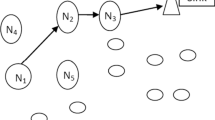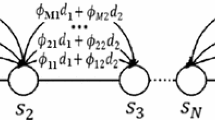Abstract
Wireless sensor networks produce immense sensor readings within a report interval to the sink. So transfer of information in a resource constrained wireless environment is difficult. Compressive sensing overcomes the resource constrains in wireless environment by exploiting sparsity in transfer with fewer measurement and recovery of original signal. In this research Intelligent Neighbor Aided Compressive Sensing (INACS) scheme is proposed for efficient data assembly in spatial and temporal correlated WSNs. Sparse Matrix has been formed with spatial and temporal coordinates for data transfer. In every sensing period, the sensor node just sends the readings within the sensing period to uniquely selected neighbour based on a correlation. The transmission period provides significant improvement with compressed data using INACS with the measurement matrix. Thus INACS provides reduction in number of transmission and higher reconstruction accuracy. INACS has been compared with Compressive wireless sensing for reduction in number of transmissions achieved. The time series analysis with INACS has been done to validate the simultaneous association between number of transmissions and time period.


Similar content being viewed by others
References
Donoho, D. L. (2006). Compressed sensing. IEEE Transactions on Information Theory,52(4), 1289–1306.
Sarvotham, S., Baron, D., Wakin, M., Duarte, M. F., & Baraniuk, R. G. (2005). Distributed compressed sensing of jointly sparse signals. In Asilomar conference on signals, systems, and computers (pp. 1537–1541).
Candes, E., & Romberg, J. (2007). Sparsity and incoherence in compressive sampling. Inverse Problems,23(3), 969.
Tropp, J. A., Gilbert, A. C., & Strauss, M. J. (2006). Algorithms for simultaneous sparse approximation part I: Greedy pursuit. Signal Processing,86(3), 572–588.
Luo, C., Wu, F., Sun, J., & Chen, C. W. (2009). Compressive data gathering for large-scale wireless sensor networks. In Proceedings of the 15th annual international conference on mobile computing and networking (pp. 145–156). ACM.
Cheng, J., Ye, Q., Jiang, H., Wang, D., & Wang, C. (2013). STCDG: An efficient data gathering algorithm based on matrix completion for wireless sensor networks. IEEE Transactions on Wireless Communications,12(2), 850–861.
Do, T. T., Gan, L., Nguyen, N. H., & Tran, T. D. (2012). Fast and efficient compressive sensing using structurally random matrices. IEEE Transactions on Signal Processing,60(1), 139–154.
Quan, L., Xiao, S., Xue, X., & Lu, C. (2016). Neighbor-aided spatial-temporal compressive data gathering in wireless sensor networks. IEEE Communications Letters,20(3), 578–581.
Leinonen, M., Codreanu, M., & Juntti, M. (2018). Distributed distortion-rate optimized compressed sensing in wireless sensor networks. IEEE Transactions on Communications,66(4), 1609–1623.
Zhang, D. G., Zhang, T., Zhang, J., Dong, Y., & Zhang, X. D. (2018). A kind of effective data aggregating method based on compressive sensing for wireless sensor network. EURASIP Journal on Wireless Communications and Networking,2018(1), 159.
Kong, L., Xia, M., Liu, X. Y., Chen, G., Gu, Y., Wu, M. Y., et al. (2014). Data loss and reconstruction in wireless sensor networks. IEEE Transactions on Parallel and Distributed Systems,25(11), 2818–2828.
Arjoune, Y., Kaabouch, N., El Ghazi, H., & Tamtaoui, A. (2018). A performance comparison of measurement matrices in compressive sensing. International Journal of Communication Systems,31(10), e3576.
Gan, H., Xiao, S., & Zhao, Y. (2018). A large class of chaotic sensing matrices for compressed sensing. Signal Processing,149, 193–203.
Zaeemzadeh, A., Joneidi, M., & Rahnavard, N. (2017). Adaptive non-uniform compressive sampling for time-varying signals. In 2017 51st Annual conference on information sciences and systems (CISS) (pp. 1–6). IEEE.
Huang, J., & Soong, B. H. (2019). Cost-aware stochastic compressive data gathering for wireless sensor networks. IEEE Transactions on Vehicular Technology,68(2), 1525–1533.
Fan, Y., Chen, Q., & Yu, J. (2009). Topology control algorithm based on bottleneck node for large-scale WSNs. In 2009 International conference on computational intelligence and security (Vol. 1, pp. 592–597). IEEE.
Choi, J. W., Shim, B., Ding, Y., Rao, B., & Kim, D. I. (2017). Compressed sensing for wireless communications: Useful tips and tricks. IEEE Communications Surveys and Tutorials,19(3), 1527–1550.
Fazel, F., Fazel, M., & Stojanovic, M. (2013). Random access compressed sensing over fading and noisy communication channels. IEEE Transactions on Wireless Communications,12(5), 2114–2125.
Sejdić, E., Orović, I., & Stanković, S. (2018). Compressive sensing meets time–frequency: An overview of recent advances in time–frequency processing of sparse signals. Digital Signal Processing,77, 22–35.
Bajwa, W., Haupt, J., Sayeed, A., & Nowak, R. (2006). Compressive wireless sensing. In Proceedings of the 5th international conference on Information processing in sensor networks (pp. 134–142). ACM.
Candès, E. J., & Wakin, M. B. (2008). An introduction to compressive sampling [a sensing/sampling paradigm that goes against the common knowledge in data acquisition]. IEEE Signal Processing Magazine,25(2), 21–30.
Candes, E. J., Romberg, J. K., & Tao, T. (2006). Stable signal recovery from incomplete and inaccurate measurements. Communications on Pure and Applied Mathematics: A Journal Issued by the Courant Institute of Mathematical Sciences,59(8), 1207–1223.
Rauhut, H. (2010). Compressive sensing and structured random matrices. Theoretical Foundations and Numerical Methods for Sparse Recovery,9, 1–92.
Blanchard, J. D., Cartis, C., & Tanner, J. (2011). Compressed sensing: How sharp is the restricted isometry property? SIAM review,53(1), 105–125.
Acknowledgement
This work was supported by the Faculty Research Grant, from University of Malaya [GPF007A-2018].
Author information
Authors and Affiliations
Corresponding author
Additional information
Publisher's Note
Springer Nature remains neutral with regard to jurisdictional claims in published maps and institutional affiliations.
Rights and permissions
About this article
Cite this article
Alagirisamy, M., Chow, CO. & Noordin, K.A.B. Intelligence Framework Based Analysis of Spatial–Temporal Data with Compressive Sensing Using Wireless Sensor Networks. Wireless Pers Commun 112, 91–103 (2020). https://doi.org/10.1007/s11277-019-07017-2
Published:
Issue Date:
DOI: https://doi.org/10.1007/s11277-019-07017-2




